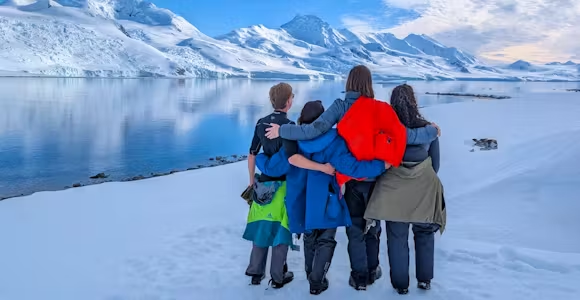
When to go to Antarctica
Choosing when to go to Antarctica is a key part of planning a cruise, with each month of the season offering a different side of the continent.
Discover MoreWeddell seals are the most commonly seen species of seal along the Antarctic Peninsula. They’re also one of the largest seals, reaching over 10 feet (3.3m) in length. They can be seen hauled up on ice floes or sleeping on beaches close to the water. Weddell seals are mostly solitary, though early in the season it’s not uncommon to see adult females with their pups, which are born around October, just before the start of the Antarctic cruise season.
Weddell seals are fantastic deep divers, chasing after fish and krill. They’re also highly vocal, with males in particular being great singers, with trills and chirps used to defend their territories beneath the ice.
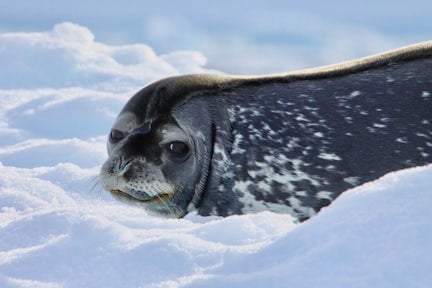
Weddell seal
Along with the orca, the leopard seal is Antarctica’s apex predator. Commonly seen dozing on ice floes, they are solidly built animals, with large and almost-snake-like heads. The typical image of a leopard seal is of an animal lying on an ice floe near a penguin colony, with an eye half-cocked for a quick meal.While penguins are an important part of their diet, leopard seals eat anything from krill and small fish up to young crabeater seals.
In the water, they are graceful swimmers, and like most predators show a great curiosity, sometimes swimming around zodiacs to check them out and sticking their heads out of the water to contemplate the occupants.

Leopard seal
Although they’re rarely seen in more than threes or fours, crabeater seals are thought to be the most abundant seal species in the world. Their success is down to their food source: not crabs as one might suppose, but the krill that swarms in vast numbers in the Southern Ocean. They have highly specialised teeth that act as sieves to filter krill out of the water, in much the same way as a baleen whale.
You won’t see a crabeater seal on land, as these are purely creatures of the pack ice. They’re easily distinguished from Weddell seals by their silvery brown fur and long pointed faces. Young crabeaters are a favourite prey item of leopard seals.

Crabeater seal
The thriving Antarctic fur seal is testament to the ability of nature to bounce back. Hunted almost to extinction for their pelts in the early 19th century, there are nearly four millions of them in South Georgia, their most important breeding location.
Visit South Georgia in November at the height of the breeding season, and there can be so many male fur seals on the beach that it’s not possible to land safely. Returning in the new year, the seas froth with an almost countless number of pups. Both are an incredible sight.
Fur seals can also be found on the northern tip of the Antarctic Peninsula and the South Shetland Islands.

Antarctic fur seal
Elephant seals are the giants of the seal world. Fully grown males are the largest and heaviest sea mammals that aren’t whales, reaching nearly 15 feet (4.5m) in length and weighing over four tons. The rather more modest females are less than a quarter of their size and weight.
Southern elephant seals congregate on South Georgia as well as the Falkland Islands, though they can also be seen as far south as the South Shetland Islands. The start of the polar cruise season just overlaps with the end of their breeding season, but early visitors can often see adult males jousting for territory and females. In late summer, elephant seals congregate for an annual moult, when they can look particularly moth-eaten.

Southern elephant seals
Of the Antarctic seals, one species that is very rare to see is the Ross seal. This seal breeds south of the Antarctic Circle among the thick pack, and so isn’t spotted on traditional Peninsula trips; only cruises on icebreaker ships heading far south stand any chance of a sighting.
For Peninsula cruises sailing from Ushuaia, there is usually a decent chance of spotting South American sea lions hauled up on rocky islands along the Beagle Channel. These sea lions can also be seen in the Falkland Islands.

South American sea lions in the Beagle Channel
Seals can be seen in Antarctica throughout the visitor season, from November through to March. Species along the Peninsula have their pups at the very start of spring in October. Seals can be seen in Antarctica throughout the visitor season, from November through to March.
The biggest variation in seal watching comes with South Georgias' fur seals and elephant seals. Visitors in November may catch the last of the male elephant seal ‘beachmasters’ jousting to defend their harems, while enormous numbers of male fur seals claiming a shoreline breeding spot: their sheer density sometimes makes it unfeasible to land. In the new year, young pups crowd the beaches, and turn the sea into ‘fur seal soup.’

Watching a leopard seal on an ice floe
To help protect Antarctica’s wildlife, strict wildlife watching guidelines are in place that all visitors must follow during a landing or zodiac cruise, developed by the International Association of Antarctica Tour Operators (IAATO).
Visitors must always stay at least 15 feet (5m) away from wildlife, but for safety greater distances are recommended for fur seals, leopard seals and jousting elephant seals. Keep a minimum of 75 feet (25m) from nursing seals. Pups are often left alone when the mother is feeding and should never be approached.
Never walk between a seal and its access to the sea, or tower over a seal to break its horizon. Any behaviour that causes a response in a seal other than a raised head must be avoided.

Watching crabeater seals from a safe distance
Antarctic seals are heavily dependent on pack ice, and so find themselves particularly exposed to climate change, especially given recent reductions in the extent of Antarctica’s winter sea ice.
In the early 19th century, Antarctic fur seals were almost completely wiped out through being hunted for their pelts, while elephant seals were also killed for their blubber. Both species have shown an extraordinary ability to bounce back from the brink. The massive growth in fur seal numbers around South Georgia, and a similar growth in crabeater seal numbers may have been helped by a lack of competition for krill, after the devastation of the 20th century whaling industry. Competition from the growth in commercial krill fishing today may hold a similar threat to some Antarctic seal species.
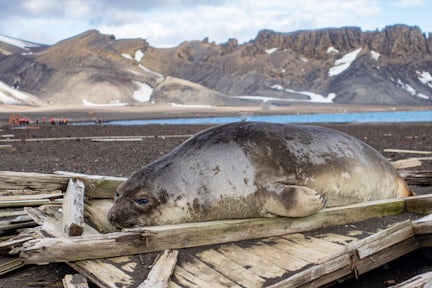
Juvenile elephant seal on Deception Island
Price Match Promise - We’ll match any price you find elsewhere for the same trip

Choosing when to go to Antarctica is a key part of planning a cruise, with each month of the season offering a different side of the continent.
Discover More
From stepping foot on polar shores to zodiac cruises, and wildlife encounters to adventure activities, here’s what you can expect from an Antarctic cruise.
Discover More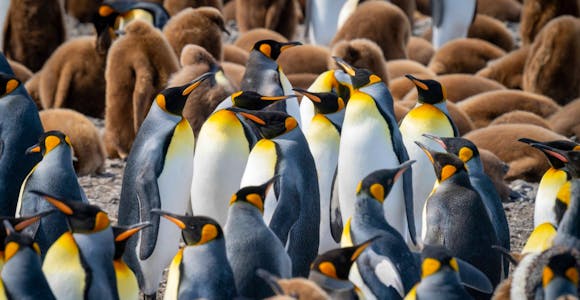
A jewel in Antarctica's crown, South Georgia is one of the world's great wildlife destinations: the Serengeti of the Southern Ocean
Discover More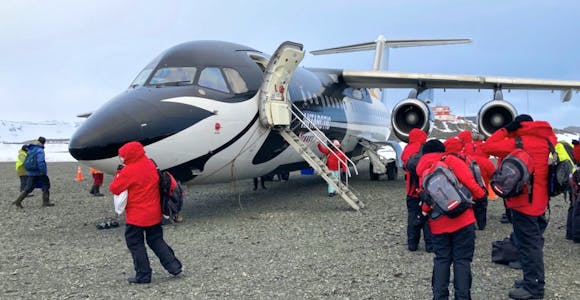
Fly & Cruise trips offer the best of Antarctica in one simple package: flying to the Peninsula in two hours to join an expedition cruise ship for a classic polar adventure.
Discover MoreWe'll spend some time listening to your aspirations, then discuss the kind of experience that might suit you.
Next we'll discuss the options, shortlist the best trips for you and present you our impartial recommendations.
We'll place a 24 hour hold on your preferred option - without obligation - whilst we talk through the details.